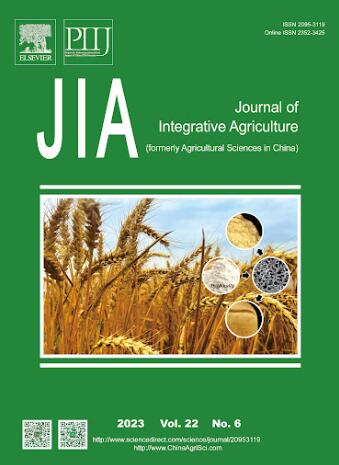胚珠数是调节种子产量的后起之秀:希望还是幻想
IF 4.4
1区 农林科学
Q1 AGRICULTURE, MULTIDISCIPLINARY
引用次数: 0
摘要
油菜籽(Brassica napus L.)是全球第二大优质油料作物,主要用于生产植物油和蛋白粉。育种者的主要目标之一是培育可持续生产的高产油菜品种,以满足快速增长的人口需求。除了豆荚数、每粒籽粒数(SS)和千粒重(TSW)外,胚珠数(ON)是决定单株产量和最终种子产量的决定性因素。近年来,人们一直在努力剖析这些复杂性状的遗传和分子基础。然而,控制这些性状的基因或基因座的报道仍然相对较少。这篇综述重点介绍了模式植物(.)萌发和发育的最新激素和分子基础。这篇综述还汇编了胚珠发育和数量的激素、分子和遗传机制方面的研究成果,并在模式植物物种(.)和栽培物种(.)之间架起了一座理解的桥梁。该报告将为植物生物学的初级研究和应用研究开辟一条新的通道,并有利于油菜育种计划。这些文献将激发研究兴趣,以进一步了解胚珠数的决定、其在产量提高中的作用以及在育种计划中的可能应用。本文章由计算机程序翻译,如有差异,请以英文原文为准。
Ovule number a rising star to regulate seed Yield: Hopes or hypes
Rapeseed (Brassica napus L.) is the second most premium oilseed crop, mainly grown for vegetable oil and protein meal around the globe. One of the main goals for breeders is to produce high-yield rapeseed cultivars with sustainable production to meet the requirements of the fast-growing population. Besides the pod number, seeds per silique (SS), and thousand-seed weight (TSW), ovule number (ON) is the decisive yield determining factor of a single plant and final seed yield. In recent years, tremendous efforts have been made to dissect the genetic and molecular basis of these complex traits. Still, only relatively few genes or loci controlling these traits have been reported. This review highlighted the updated hormonal and molecular basis of ON and development in model plants (. ). This review also compiled efforts at the hormonal, molecular, and genetic mechanism of ovule development and number and bridge the understanding between the model plant species (. ) and cultivated species (. ). This report will open a new corridor for primary and applied research in plant biology and benefit rapeseed breeding programs. This literature will inculcate research interest to understand further ovule number determination, its role in yield improvement, and possible utilization in breeding programs.
求助全文
通过发布文献求助,成功后即可免费获取论文全文。
去求助
来源期刊

Journal of Integrative Agriculture
AGRICULTURE, MULTIDISCIPLINARY-
CiteScore
7.90
自引率
4.20%
发文量
4817
审稿时长
3-6 weeks
期刊介绍:
Journal of Integrative Agriculture publishes manuscripts in the categories of Commentary, Review, Research Article, Letter and Short Communication, focusing on the core subjects: Crop Genetics & Breeding, Germplasm Resources, Physiology, Biochemistry, Cultivation, Tillage, Plant Protection, Animal Science, Veterinary Science, Soil and Fertilization, Irrigation, Plant Nutrition, Agro-Environment & Ecology, Bio-material and Bio-energy, Food Science, Agricultural Economics and Management, Agricultural Information Science.
 求助内容:
求助内容: 应助结果提醒方式:
应助结果提醒方式:


